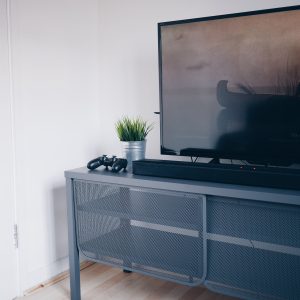Buying a TV can be very challenging if you do not know what you are supposed to check. All the specifications and acronyms thrown at you can be overwhelming, and even more worrying are the salespeople who might convince you to buy a TV you do not need. Whether you want to know what features are the most important or just some shopping advice, we have pulled up all the information you need to know when buying a TV.

Screen Size
Whether you want a high-performance or basic TV, the greatest factor that will influence your decision is screen size. Find out how many people in your family watch TV at the same time and where you are going to place it. Then choose a screen size that will work well with your space while staying within your budget. Nowadays, the sweet spot, considering factors like price, performance, and typical living room setups, falls between 55 and 65 inches.
Keep in mind that your viewing distance from the TV also matters. If you can see individual pixels on the screen, you are sitting too close to the TV. Sit at a distance that is 3 times the height of HD TVs and 1.5 times for 4K Ultra HD content. Basically, you can sit twice as close to a 4K UHD TV without compromising your viewing experience.
Although no guide can replace your personal judgment and experience, if you get the chance, head over to a store (maybe with your family in tow) and take a look at the TVs for yourself. While 4K content isn’t as common as 1080p content, its availability is on the rise through platforms like Netflix. If you plan to sit close to a very large screen, you might want to consider this higher-resolution technology.
Remember, the location of the TV in your home is important too. The advice mentioned earlier is mainly aimed at living rooms and home theaters, so you should also think about what size TV is appropriate for other areas of your home, like the bedroom or kitchen, where a smaller TV might be more suitable. Go for screen size and resolution that match the distance between you and the TV. We recommend starting with a 55-inch TV unless you’re in a compact apartment or dorm room.
Screen Resolution
Resolution refers to the number of pixels that make up the picture on the screen in terms of both horizontal rows and vertical columns. More pixels equate to a sharper picture with finer details, so a higher resolution is generally better. For a long time, the standard resolution was 1920 x 1080, commonly known as Full HD. However, the TV industry is rapidly transitioning to Ultra HD sets, also called 4K. These 4K TVs have four times the number of pixels as current HDTVs, boasting a resolution of 3840 x 2160 pixels. The main advantage of 4K TVs is that small objects on the screen appear more detailed, including text that’s sharper. Overall, images look more vivid and true to life compared to HDTVs, though the improvements might be subtle.
The increased sharpness also means you can comfortably view the screen from a shorter distance, which is especially helpful for larger TVs in regular-sized homes. The good news is that Ultra HD video content is becoming more abundant. Streaming services like Netflix, Amazon Video, and YouTube are offering more 4K content, making smart TVs and streaming devices your go-to sources for finding 4K movies and shows. Additionally, Ultra HD Blu-ray discs are gaining popularity, and most major releases are now available in 4K.
While live TV hasn’t fully embraced 4K yet, providers like DirecTV, Dish Network, and Comcast Xfinity have begun offering 4K movies. Although 4K TVs can upscale existing HD content, the results might not be as sharp as native 4K programming. While a few relatively affordable 8K TVs have entered the market, they quadruple the resolution of 4K sets, leading to a significant boost in picture quality. However, finding content that fully capitalizes on this higher resolution remains limited. Although 8K TVs are available, it is better to hold off for now.
Smart TVs
Most TVs come with Wi-Fi to connect to the internet and access services like Netflix for streaming. Smart TVs generally have better interfaces. Brands like Vizio, Samsung, TCL, and Hisense. Sony, all come with their versions of smart TVs. They either use Linux, Android, or custom-made operating systems. Most smart TVs have popular streaming services like Hulu, Netflix, Pandora, and Prime Video, but make sure the one you go for has all the apps you plan on using.
Streaming apps are also the best option for watching 4K and HDR videos so that you get the best out of your 4K TV. If you plan to stream torrents on your TV, smart TVs with the Android operating system will allow you to install VPN to protect yourself. In just a few clicks, you can get Montenegro IP with a VPN and torrent safely and anonymously.
Refresh Rate
Refresh rate, measured in Hertz (Hz), indicates how often a picture is refreshed on the screen per second. 60 Hz is the standard refresh rate. However, in scenes with fast-moving objects, a 60 Hz refresh rate can result in blurry or jittery visuals, especially on LCD HDTVs. To create a smoother picture, manufacturers have doubled the refresh rate to 120 Hz (and sometimes even up to 240 Hz).
Some newer models boast High-Frame Rate (HFR) support, meaning they can display content with higher frame rates. This contributes to smoother motion and reduced motion blur, enhancing the viewing experience, particularly for action-packed scenes like sports or fast-paced movies.
Gamers need to be even more careful with refresh rates. The latest gaming consoles will work well with 120Hz while the older ones will be good with up to 60Hz. Beware of terms like effective refresh rates which, a TV with an effective refresh rate of 120Hz is actually half the refresh rate, 60Hz.






